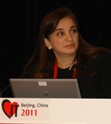资讯内容 Content
[CIT2011]Personalizing Choices in ACS Drug Therapy——Roxana Mehran教授主旨演讲
国际循环网版权所有,谢绝任何形式转载,侵犯版权者必予法律追究。

Dr Roxana Mehran, New York, enthusiastically presented an overview of ACS pharmacological therapies and future directions during the morning’s CIT-TCT Plenary Session. Pharmacological treatment of patients with CVD has improved over the years to decrease ischemic and bleeding complications but as most drugs that reduce ischemia also increase bleeding, the offsetting impact of adverse ischemic hemorrhagic events must be carefully examined. The net balance of ischemia and bleeding may vary tremendously with the risk profile of the individual patient for each complication and the follow-up duration. Consequently, models are needed to assess a patient’s risk for bleeding as well as ischemic complications to further enhance treatment of the patients with therapies that are efficacious and also safe – there is that “sweet spot” between safety and efficacy that we should be striving for.
The strategies available for ACS treatment are many in number and it can be difficult and confusing for physicians to “choose from this vast menu” based on so many clinical trials. Doctor Mehran outlined the four anticoagulant choices (UFH, direct antithrombins, LMWH, pentasaccharides) and briefly summarized the major findings of the randomized clinical trials investigating them and some of the clinical applications of these findings. As expected these results are usually a trade-off between ischemic and bleeding benefits both short term and long term.
Doctor Mehran posed the question: How do we use evidence to improve medical decision-making? The traditional evidence-based medicine approach takes good, intermediate and bad outcomes in combination from randomized controlled trials to obtain a mean treatment effect – this represents the “average” patient. In real life, however, there are no average patients. We currently have the tools to put together practical and usable risk scores and adjusting these from what we know from evidence-based medicine and registries such as the National Cardiovascular Data Registry (NCDR) which is a repository for comparative effectiveness research from the American College of Cardiology. Doctor Mehran believes they are finding tremendous information from sources such as the NCDR which probably would otherwise be unavailable from randomized clinical trials. At the Mid-American Heart Institute, she believes the ePRISM system being implemented there, whereby clinical risk modeling occurs at the point-of-care, is the “future of medicine”. They have done away with the traditional consent forms and a computer-generated bedside risk assessment is made based on that specific patient’s demographics and baseline characteristics. She gave examples of the application of their risk models to individual patients. Doctor Mehran has developed her own risk scores for non-CABG bleeding drawing from HORIZON and ACUITY trial data with factors based on female gender, advanced age, elevated serum creatinine, WBC count, anemia and non-ST-segment elevation MI or segment elevation MI. This ACS risk score provides a measurable risk of bleeding or ischemic risk of a patient presenting with ACS. “A new era of man vs. machine is dawning” whereby machines can help us make important and evidence-based decisions on individual patients rather than “average” patients.